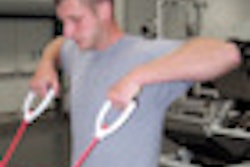Diagnostic imaging practices have become increasingly difficult to manage, largely due to hard-hitting reimbursement cuts from the Deficit Reduction Act (DRA). At the same time, high rates of work-related musculoskeletal disorders (WRMSD) among imaging professionals are costing employers billions of dollars a year. Workforce shortages are affecting productivity, patient care, and reimbursement revenue.
After years of working with diagnostic imaging departments to address their ergonomic needs, two areas of disconnect have become readily apparent. First, the risk for WRMSD is often not the result of the work being done, but rather how it is being done. Second, sustainability in work safety is hard to achieve.
Therefore, it seemed that if a methodology could be designed to evaluate and improve the process and procedures surrounding diagnostic imaging work, the risk of injury could be reduced. That same methodology could also be used to build sustainability in a work safety program by involving the worker in the program development.
Ergonomics without the structure for continuous process improvement loses its momentum. Often, workers who receive ergonomic training are initially motivated to change, but they end up reverting to old behaviors because there is no structure for permanence. Likewise, many are simply resistant to change because they feel a mandate for change is being required without their consent. Creating a participatory ergonomics program that includes worker input in its development provides the basis for longevity in work safety. Involving staff in developing a behavior-based safety program that accurately reflects their work experience creates something they can believe in.
Many facilities are looking for ways to increase throughput to improve the bottom line, yet increasing procedure volumes force radiologists and imaging professionals to cope with more data, more patients, and more exposure to injury risk. Is it possible to increase productivity while simultaneously reducing risk for WRMSD and improving both patient care and staff work experience?
What if you could do the following?
- Be responsive to the needs of your patients
- Not waste time -- either yours or your patients'
- Improve productivity
- Reduce exposure to risk for injury
- Improve the accuracy of patient care
Applying lean management principles can help achieve these goals. Lean management is not actually a cost-reduction program, but rather a management strategy for process improvement. It's about teaching people how to think differently about their work.
The most effective ergonomics programs help workers understand the risk factors for injury so they can make corresponding changes in their work habits. Similarly, helping workers think outside the box in their problem-solving helps them experience the benefits of long-term, sustainable process improvement, enhancing the overall work experience. Through process improvement, practices can increase productivity and reduce exposure to risk for work-related injury.
Lean management principles have been successfully used for decades, primarily in manufacturing industries. The philosophy, initiated by the Toyota Corporation in the 1960s, focuses on eliminating wasted time and resources and seeks to identify which tasks are value-added and which are nonvalue-added processes.
Lean management is quickly becoming a valuable tool in healthcare, where the driving forces of a process (patient care) are constantly changing based on a complexity of influences. Wasted time, money, and resources are common problems in healthcare.
Value added
As diagnostic imaging capabilities have evolved, the blending of new technologies often creates an overlap of services. However, change is seldom a matter of "out with the old, and in with the new." There are crossover periods, training requirements, and learning curves each time a new modality or technological advancement is introduced. Frequently, this results in duplication of work.
Protocols and procedures generally are not evaluated for overlap or the effectiveness of the process. Furthermore, establishing new procedures seldom involves those that are in the best position to evaluate their effectiveness, i.e., the patient and the worker.
Applying lean principles offers a means for eliminating waste, providing for a higher level of patient care in the most efficient and effective manner possible. Streamlining the process of patient care has the added value of decreasing the duration of exposure to risk factors for WRMSD.
Keeping staff healthy and productive in diagnostic imaging is critical to profitability, as staff shortages leave management drowning in unrealistic administrative challenges. Blending ergonomics with lean process improvement helps reduce injuries and increase productivity, while improving the quality of patient care and the patient care experience.
Value Stream Mapping
A central concept of lean practice is the use of a tool called Value Stream Mapping, which helps define the existing process or evaluate the projected benefits of an improved process by identifying its value-added versus nonvalue-added aspects.
In the case of diagnostic imaging, the process would be the diagnostic test being performed. Evaluating the entire process, including all of the internal and external influences that affect the process, is the first step in identifying areas of waste and exposure to risk for injury.
For example, we all know the frustrations of coordinating the necessary steps and communications involved in performing an exam at the patient's bedside. From receiving the order, to coordinating the exam with the nurse who is caring for the patient, to working around other tests being performed, meals being served, visiting family members, etc. -- the potential for wasted time is enormous.
Other barriers include transporting equipment and having to make accommodations to the work environment in the patient's room, which can extend scanning time and exposure to risk factors for injury. Patel and colleagues estimated that portable vascular imaging increased overall study time by 17.7 minutes per test. This resulted in a potential loss of revenue of nearly $60,000 on average for a department that performs 18% of their exams at patient bedside.
Value Stream Mapping provides the basis for evaluating the current route of delivery and identifying wastes associated with various aspects of the procedure in order to improve the outcome for both the patient and the worker. Sometimes it's a matter of inappropriate decision-making criteria, and other times it's ineffective utilization of resources.
Understanding lean principles
Blending aspects of lean healthcare with ergonomics provides tools for improving the overall work environment that are not otherwise available. As an example, a team of occupational health managers at a vascular lab and an outside ergonomics consultant identified the high rate of bedside exams being performed as a source of increased WRMSD symptoms.
A large majority of the portable exams being conducted were not medically necessary, but were performed to overcome the lack of adequate patient transport and resulting delays. Taking a look at the larger picture and the elements of the process contributing to the waste, they were able to improve patient transportation flow and reduce the number of unnecessary bedside exams. Eliminating unnecessary bedside exams not only improved productivity, but ultimately also reduced the exposure to risk for work-related injury.
In another example, a facility sought to perform all inpatient exams at the patient's bedside to improve patient-centered care and decrease the transportation burden on the sick patient. Their priority of putting the patient first meant doing everything they could to create an environment of healing for their hospital patients.
Consequently, bringing their imaging services to the patient was the desired outcome, yet how could they achieve this without the burden of waste and increased risk for WRMSD that had traditionally been associated with portable exams?
Through the application of lean principles combined with ergonomics, this department was able to re-think their traditional process to reduce nonvalue-added time and communications delays related to ordering and completing bedside exams, as well as address the ergonomic issues commonly associated with portable studies. Best of all, the patient's experience was improved and the sonographer's exposure to risk factors was reduced.
Sustainability
Helping workers become the architects of their own work environment creates an atmosphere of mutual trust and respect. Sustainable work safety is achieved through an ongoing program for corporate culture change, such as through the application of lean management principles.
Lean healthcare is increasingly being recognized as a strategic resource for effective change in healthcare organizations, with significant successes reported. Process improvement can bring about and sustain positive change, helping staff through the implementation of change by demonstration and example and by providing the tools they need to work more safely and effectively.
By Susan L. Murphey
AuntMinnie.com contributing writer
April 30, 2008
Susan L. Murphey, RDMS, RDCS, CECD, is president of Essential Ergonomics, a Shoreline, WA-based consulting firm specializing in ergonomics and process management in healthcare. The company can be contacted at 206-365-5253 or via its Web site: www.essentialergonomics.com.
References
Doss R, Orr C. "Lean Leadership in Healthcare." (White Paper.) Retrieved November 1, 2007, from www.rwd.com.
"Going Lean in Health Care." IHI Innovation Series. (White Paper.) Cambridge, MA: Institute for Healthcare Improvement; 2005. Retrieved November 1, 2007, from www.ihi.org.
Patel D, et al. "Appropriate Resource Utilization in Portable Noninvasive Vascular Studies: The Role of Disruptive Technology." Journal for Vascular Ultrasound. 2006;30(1):35-58.
Womak JP, Jones DT. Lean Thinking: Banish Waste and Create Wealth in Your Corporation. New York: Simon and Schuster, Inc.; 1996, Second Edition 2003.
Related Reading
Kneeling, standing on the job boost arthritis risk, January 8, 2008
Repetitive stress injuries in radiology? You bet, November 28, 2007
Heavy keyboard use won't trigger carpal tunnel woe, November 28, 2007
U.S. government issues update on WRMSDs in sonography, December 25, 2006
Worksite assessments reduce risk exposure and improve productivity, May 17, 2006
Copyright © 2008 Essential Ergonomics



















